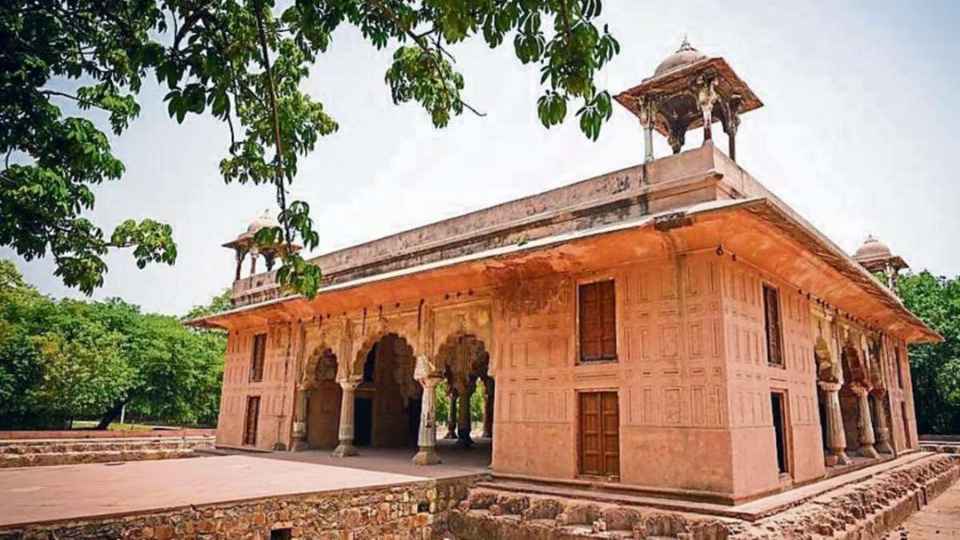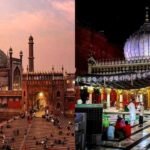Reviving History: Roshanara Bagh, Delhi’s Mughal-era Garden, Gets a Facelift

Nestled amidst the hustle and bustle of Delhi lies a tranquil oasis of history and greenery – Roshanara Bagh. This Mughal-era garden, named after Princess Roshanara Begum, has recently undergone a significant refurbishment, breathing new life into its centuries-old charm. In this article, we delve into the transformation of Roshanara Bagh and explore the changes that have revitalized this iconic piece of Delhi’s heritage.
Rediscovering Roshanara Bagh:
Originally commissioned in the 17th century by Emperor Shah Jahan’s daughter, Roshanara Begum, Roshanara Bagh has long been celebrated for its stunning design and serene ambiance. Over the years, however, neglect and urbanization had taken their toll on this historic site, dimming its former glory. But now, thanks to a collaborative effort between government authorities and conservationists, Roshanara Bagh has been given a new lease on life.
Restoration Efforts:
The restoration of Roshanara Bagh involved meticulous planning and execution to preserve its architectural heritage while enhancing its accessibility and sustainability. One of the most significant changes is the restoration of the garden’s original layout, including its intricate water channels, pavilions, and lush greenery. Careful attention was paid to using traditional techniques and materials wherever possible to maintain the garden’s authenticity.
Enhanced Amenities:
In addition to restoring its historical elements, Roshanara Bagh has also been equipped with modern amenities to improve the visitor experience. New pathways and seating areas have been added, making it easier for visitors to explore the garden and relax amidst its natural beauty. Furthermore, facilities such as restrooms and information kiosks have been installed to cater to the needs of tourists and locals alike.
Cultural Revival:
The revitalization of Roshanara Bagh isn’t just about restoring its physical infrastructure; it’s also about reigniting its cultural significance. The garden is now being used as a venue for various cultural events, including music concerts, art exhibitions, and heritage walks. These activities not only showcase the rich history of Roshanara Bagh but also encourage public engagement and appreciation for Delhi’s cultural heritage.
Community Involvement:
Crucial to the success of the restoration project was the involvement of the local community. Residents living in the vicinity of Roshanara Bagh actively participated in clean-up drives and awareness campaigns, fostering a sense of ownership and pride in their heritage. Their continued support will be essential in ensuring the long-term sustainability and preservation of the garden for future generations to enjoy.
Conclusion:
The refurbished Roshanara Bagh stands as a testament to the power of preservation and collective action in safeguarding our cultural heritage. Through careful restoration and community involvement, this Mughal-era gem has been brought back to its former glory, serving as a vibrant green lung in the heart of Delhi. As visitors wander through its manicured lawns and shaded pathways, they are not just experiencing a garden but stepping into a living piece of history, where the past seamlessly merges with the present.
Top 20 FAQs about Reviving History: Roshanara Bagh, Delhi’s Mughal-era Garden, Gets a Facelift
1. What is Roshanara Bagh? Roshanara Bagh is a historic Mughal-era garden located in Delhi, named after Princess Roshanara Begum, daughter of Emperor Shah Jahan.
2. Why is Roshanara Bagh significant? Roshanara Bagh is significant for its historical importance, stunning Mughal architecture, and serene ambiance, making it a popular destination for tourists and locals alike.
3. Who commissioned the construction of Roshanara Bagh? Roshanara Bagh was commissioned by Princess Roshanara Begum, daughter of Emperor Shah Jahan, in the 17th century.
4. What led to the refurbishment of Roshanara Bagh? Neglect and urbanization over the years had led to the deterioration of Roshanara Bagh, prompting authorities to undertake a refurbishment project to restore its former glory.
5. What were the main goals of the restoration project? The main goals of the restoration project were to preserve Roshanara Bagh’s architectural heritage, enhance its accessibility and sustainability, and revitalize its cultural significance.
6. What changes were made to Roshanara Bagh during the refurbishment? Changes made during the refurbishment included restoring the garden’s original layout, adding modern amenities such as pathways and seating areas, and using traditional techniques and materials for authenticity.
7. How was community involvement crucial to the restoration project? Community involvement was crucial as local residents participated in clean-up drives, awareness campaigns, and cultural events, fostering a sense of ownership and pride in Roshanara Bagh’s heritage.
8. What amenities were added to Roshanara Bagh during the refurbishment? New amenities added to Roshanara Bagh included pathways, seating areas, restrooms, and information kiosks, improving the visitor experience and accessibility.
9. How is Roshanara Bagh being used post-restoration? Post-restoration, Roshanara Bagh is being used as a venue for various cultural events, including music concerts, art exhibitions, and heritage walks, to showcase its rich history and cultural significance.
10. What efforts were made to maintain Roshanara Bagh’s authenticity during the restoration? Efforts were made to maintain Roshanara Bagh’s authenticity by using traditional techniques and materials wherever possible, ensuring that the garden retained its original charm and character.
11. Is Roshanara Bagh open to the public? Yes, Roshanara Bagh is open to the public, allowing visitors to explore its manicured lawns, shaded pathways, and historical monuments.
12. Are there guided tours available at Roshanara Bagh? Yes, guided tours and heritage walks are available at Roshanara Bagh, providing visitors with insights into its history, architecture, and cultural significance.
13. What role did government authorities play in the restoration project? Government authorities played a significant role in funding and overseeing the restoration project, working in collaboration with conservationists and local communities.
14. How has the local community benefited from the restoration of Roshanara Bagh? The local community has benefited from the restoration of Roshanara Bagh through increased tourism, job opportunities, and a renewed sense of pride in their heritage.
15. Are there any future plans for Roshanara Bagh? Future plans for Roshanara Bagh may include further conservation efforts, expansion of cultural activities, and continued community engagement to ensure its long-term sustainability.
16. Can Roshanara Bagh be rented for private events? Yes, Roshanara Bagh can be rented for private events such as weddings, photo shoots, and corporate gatherings, subject to approval and regulations.
17. Is Roshanara Bagh accessible for people with disabilities? Efforts have been made to make Roshanara Bagh accessible for people with disabilities, with wheelchair ramps and accessible facilities provided throughout the garden.
18. Are there any restrictions on photography at Roshanara Bagh? Photography is generally allowed at Roshanara Bagh for personal use, but restrictions may apply during certain events or in sensitive areas.
19. How can visitors contribute to the preservation of Roshanara Bagh? Visitors can contribute to the preservation of Roshanara Bagh by respecting its rules and regulations, disposing of trash responsibly, and participating in conservation efforts and awareness campaigns.
20. Where can I find more information about Roshanara Bagh? More information about Roshanara Bagh, including its history, visiting hours, and upcoming events, can be found on official websites, tourism portals, and local guidebooks.
Register for My Upcoming Masterclass HERE
See You in the Live Masterclass
Sunil Chaudhary stands as a preeminent global Leading digital coach, boasting a diverse clientele hailing from over 50 nations. Renowned for his prowess as an exemplary SEO expert, business automation coach, and landing page authority, Chaudhary also holds the distinction of being esteemed as the finest business coach in India. Beyond technical domains, he imparts invaluable insights into mindset, success, and life skills, thus encompassing a holistic approach to mentorship.
Join FREE Courses HERE
Know The Author:
 Sunil Chaudhary aka Suniltams Guruji is India’s Leading Digital Coach. He provides complete Digital Skill Development Coaching with great support. Sunil has trained more than 25000 students and helped more than 1100 businesses so far. Sunil is a well-known face across the world for Digital Coaching.
Sunil Chaudhary aka Suniltams Guruji is India’s Leading Digital Coach. He provides complete Digital Skill Development Coaching with great support. Sunil has trained more than 25000 students and helped more than 1100 businesses so far. Sunil is a well-known face across the world for Digital Coaching.
Digital Success Coach | Best SEO Coach India | Mindset Coach | Life Success Coach
Related posts:
 “From the ancient streets of Baku’s Old City to the fiery Yanar Dag, here are 5 amazing places you should definitely see when you visit Azerbaijan!”
“From the ancient streets of Baku’s Old City to the fiery Yanar Dag, here are 5 amazing places you should definitely see when you visit Azerbaijan!”
 Varanasi to Amritsar: 5 Spiritual Places to Visit in India this February
Varanasi to Amritsar: 5 Spiritual Places to Visit in India this February
 Maha Shivratri: Top 5 Famous Shiva Temples in Jammu and Kashmir to Visit
Maha Shivratri: Top 5 Famous Shiva Temples in Jammu and Kashmir to Visit
 Japan introduces e-Visa for Indian tourists: Top 5 places to visit in the island country
Japan introduces e-Visa for Indian tourists: Top 5 places to visit in the island country
 Kalpeni – A Tranquil Oasis in Lakshadweep
Kalpeni – A Tranquil Oasis in Lakshadweep
 Welcome to Ayodhya Mandir राम!
Welcome to Ayodhya Mandir राम!
 Ultimate Guide to Planning a Trip to Mauritius
Ultimate Guide to Planning a Trip to Mauritius
 Ramadan 2024: 6 Must-Visit Delhi Eateries to Relish Wholesome Iftar Feast
Ramadan 2024: 6 Must-Visit Delhi Eateries to Relish Wholesome Iftar Feast
 Exploring the Heart of Jharkhand: 10 Fun Things To Do in Ranchi
Exploring the Heart of Jharkhand: 10 Fun Things To Do in Ranchi





